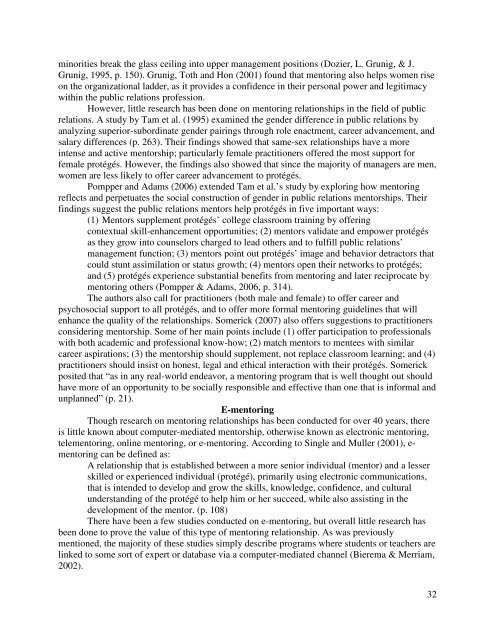2010 - Public Relations Society of America
2010 - Public Relations Society of America
2010 - Public Relations Society of America
You also want an ePaper? Increase the reach of your titles
YUMPU automatically turns print PDFs into web optimized ePapers that Google loves.
minorities break the glass ceiling into upper management positions (Dozier, L. Grunig, & J.<br />
Grunig, 1995, p. 150). Grunig, Toth and Hon (2001) found that mentoring also helps women rise<br />
on the organizational ladder, as it provides a confidence in their personal power and legitimacy<br />
within the public relations pr<strong>of</strong>ession.<br />
However, little research has been done on mentoring relationships in the field <strong>of</strong> public<br />
relations. A study by Tam et al. (1995) examined the gender difference in public relations by<br />
analyzing superior-subordinate gender pairings through role enactment, career advancement, and<br />
salary differences (p. 263). Their findings showed that same-sex relationships have a more<br />
intense and active mentorship; particularly female practitioners <strong>of</strong>fered the most support for<br />
female protégés. However, the findings also showed that since the majority <strong>of</strong> managers are men,<br />
women are less likely to <strong>of</strong>fer career advancement to protégés.<br />
Pompper and Adams (2006) extended Tam et al.’s study by exploring how mentoring<br />
reflects and perpetuates the social construction <strong>of</strong> gender in public relations mentorships. Their<br />
findings suggest the public relations mentors help protégés in five important ways:<br />
(1) Mentors supplement protégés’ college classroom training by <strong>of</strong>fering<br />
contextual skill-enhancement opportunities; (2) mentors validate and empower protégés<br />
as they grow into counselors charged to lead others and to fulfill public relations’<br />
management function; (3) mentors point out protégés’ image and behavior detractors that<br />
could stunt assimilation or status growth; (4) mentors open their networks to protégés;<br />
and (5) protégés experience substantial benefits from mentoring and later reciprocate by<br />
mentoring others (Pompper & Adams, 2006, p. 314).<br />
The authors also call for practitioners (both male and female) to <strong>of</strong>fer career and<br />
psychosocial support to all protégés, and to <strong>of</strong>fer more formal mentoring guidelines that will<br />
enhance the quality <strong>of</strong> the relationships. Somerick (2007) also <strong>of</strong>fers suggestions to practitioners<br />
considering mentorship. Some <strong>of</strong> her main points include (1) <strong>of</strong>fer participation to pr<strong>of</strong>essionals<br />
with both academic and pr<strong>of</strong>essional know-how; (2) match mentors to mentees with similar<br />
career aspirations; (3) the mentorship should supplement, not replace classroom learning; and (4)<br />
practitioners should insist on honest, legal and ethical interaction with their protégés. Somerick<br />
posited that “as in any real-world endeavor, a mentoring program that is well thought out should<br />
have more <strong>of</strong> an opportunity to be socially responsible and effective than one that is informal and<br />
unplanned” (p. 21).<br />
E-mentoring<br />
Though research on mentoring relationships has been conducted for over 40 years, there<br />
is little known about computer-mediated mentorship, otherwise known as electronic mentoring,<br />
telementoring, online mentoring, or e-mentoring. According to Single and Muller (2001), e-<br />
mentoring can be defined as:<br />
A relationship that is established between a more senior individual (mentor) and a lesser<br />
skilled or experienced individual (protégé), primarily using electronic communications,<br />
that is intended to develop and grow the skills, knowledge, confidence, and cultural<br />
understanding <strong>of</strong> the protégé to help him or her succeed, while also assisting in the<br />
development <strong>of</strong> the mentor. (p. 108)<br />
There have been a few studies conducted on e-mentoring, but overall little research has<br />
been done to prove the value <strong>of</strong> this type <strong>of</strong> mentoring relationship. As was previously<br />
mentioned, the majority <strong>of</strong> these studies simply describe programs where students or teachers are<br />
linked to some sort <strong>of</strong> expert or database via a computer-mediated channel (Bierema & Merriam,<br />
2002).<br />
32
















